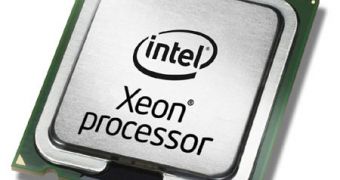Santa Clara, California-based Intel announced its new Nehalem-based Xeon processors before the Core i7 lineup, which has been designed for the consumer market. However, the chip maker's next-generation server processors are to become available only in the first quarter of 2009. Still, the fellows over at techradar were lucky enough to get their hands on one of these Nehalem-based server processors, which they subsequently tested.
The platform for testing included a pair of Intel's Nehalem EP processors that came with clock speeds of 2.8GHz each. According o techradar, these two Nehalem-based CPUs are likely to retail as the Xeon X5560 CPU, which Intel plans to debut in the first quarter of 2009. Using the SPEC CPU2006 benchmark utility, the fellows over at techradar have concluded that Intel's next-generation Xeon processors are to prove a real competitor for AMD's recently released Shanghai Opterons.
That is because, in the SPEC CPU2006 benchmark, Intel's pair of Nehalem-based processors managed to achieve a score of 160 points, which is almost double of what the Penryn-based Xeon dual-socket platform can achieve, at 90. Moreover, this score places Intel's upcoming Xeon processors above a pair of AMD's new 45nm-based Shanghai chips, clocked at 2.7GHz, which can only get 105 points. Also, the SPEC CPU2006 result reveals just how close, in terms of performance, two of Intel's Xeon processors are to four of AMD's Shanghai Opterons, which can score 190 points.
Regarding the test platform, we should mention that the benchmark was run on a system that was configured with 24GB of 1066MHz DDR3 memory, installed on a motherboard featuring a chipset that was the same with the Tylersburg, which powers Intel's current Core i7-supporting platform. Also, the result was rendered on a system powered by a Windows Server 2008 operating system.
In addition, the Nehalem EP was tested with the Stars Euler3D benchmark, which is a computational fluid dynamics simulation that majors on floating point performance. Here, the Nehalem EP managed to complete five instances in 14.34 seconds, considerably better than the 30.32 seconds scored by a pair of 2.7GHz Shanghai processors.

 14 DAY TRIAL //
14 DAY TRIAL //